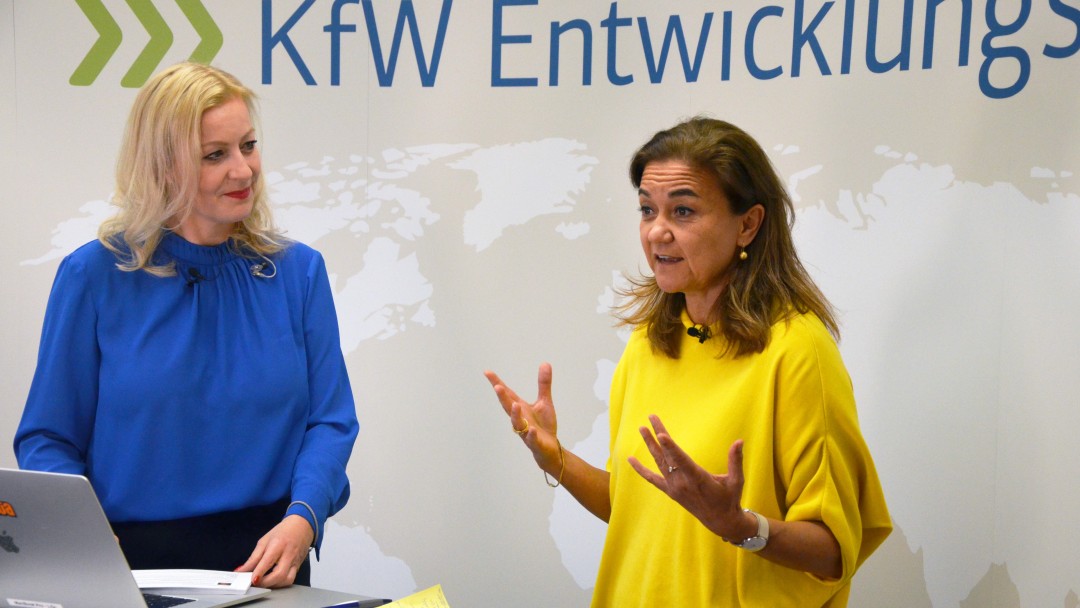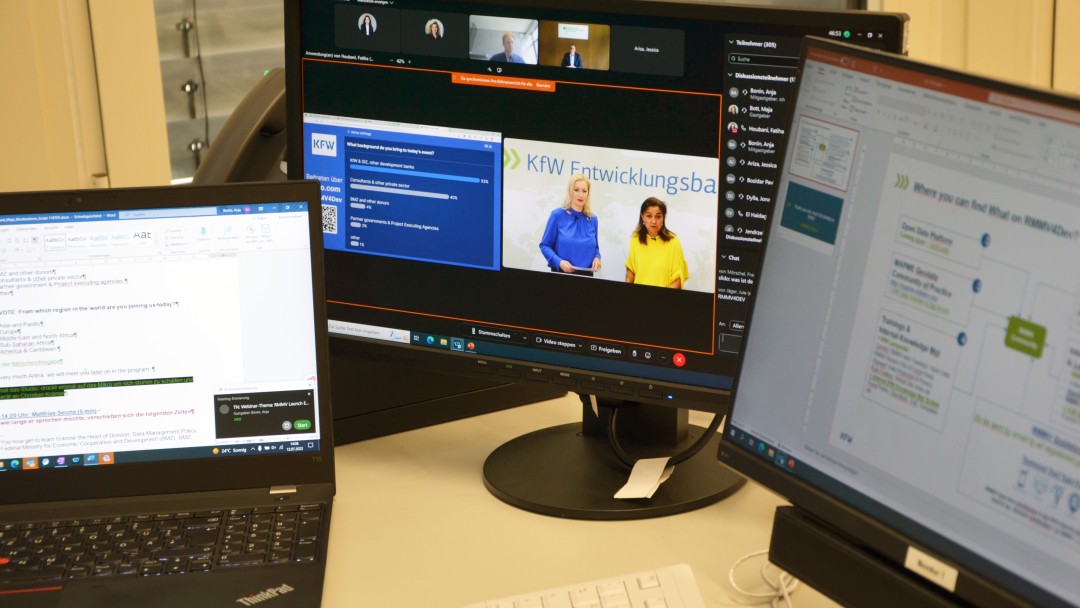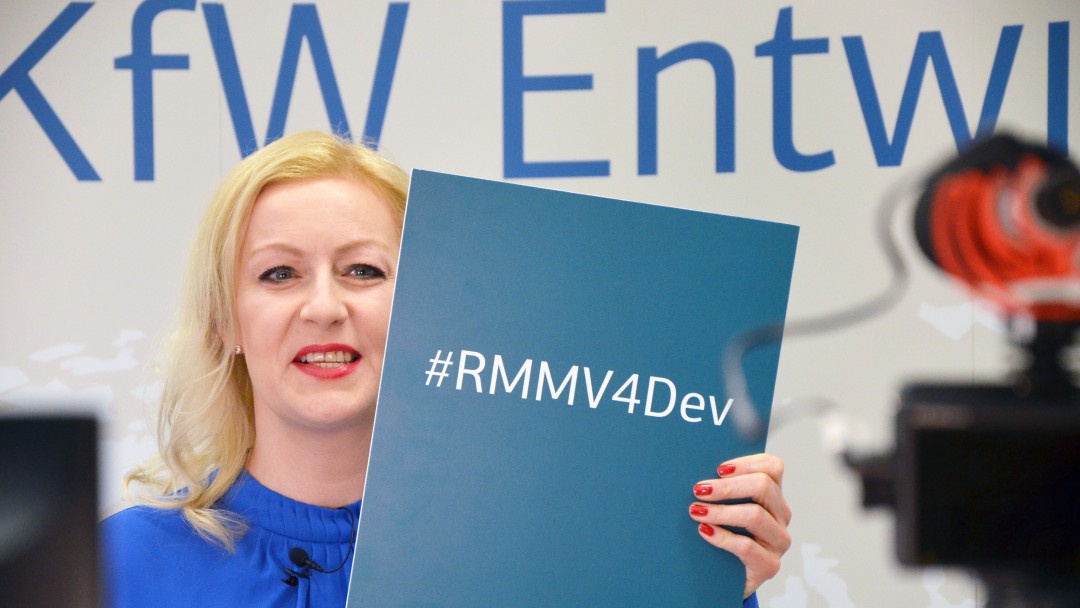News from 2022-07-20 / KfW Development Bank
Remote project monitoring made easy
KfW Development Bank is launching a guidebook on Remote Management, Monitoring and Verification
KfW had originally developed remote project management, or Remote Management, Monitoring and Verification (RMMV), for use in fragile states. Since the pandemic, however, these technologies and methods have also proven to be extremely helpful in other regions. KfW has compiled a summary of its experiences in RMMV in a guidebook, which will soon be available online. The subject matter of the guidebook has been presented to the public beforehand.

Whether drones, satellite images or internet platforms – digital technologies make it possible, at least temporarily, to track the progress of projects without being there in person. On 12 July 2022, KfW presented various RMMV projects from a wide range of sectors and regions including Montenegro, Ecuador, Pakistan and the Central African Republic in a two-hour long webinar. “There are many reasons for using RMMV approaches and tools, such as monitoring programmes involving numerous individual projects, observing large areas or following up on projects that are difficult to access,” explained Arlina Elmiger, Head of the Division for Innovation, Digitalisation and Communication at KfW at the start of the event.
Matthias Seiche, Head of Division for Data Management Policy at the German Federal Ministry for Economic Cooperation and Development (BMZ), congratulated KfW on sharing its experiences in RMMV with the professional public. He emphasised that all the stakeholders benefit from the digital transformation – from the development bank to the partner governments. Christian Krämer, Head of Department at KfW, pointed out that RMMV did not always need to be complicated; simple solutions can also be effective.
Tools for every stage of the project cycle
Maja Bott, senior sector economist at KfW, presented the guidebook, which can be classified as "digital public good". Previously, it had only been available internally but it has now been considerably expanded and revised and will soon be available for download online on the KfW website. The 200-page guidebook can be easily navigated using icons. The institutional RMMV approaches, RMMV tools and the decision matrix to help with their selection according to the respective information requirements have all been elaborated on. In addition to this, sections on the principles governing digital development, data sources, legal aspects and security topics have been developed by around 90 internal experts as well as an equal number of external experts. The guidebook also includes numerous current, practical examples to illustrate the areas of application. The integration of RMMV into the individual stages of a project cycle is also described in detail.
Dr Johannes Schielein, KfW sector economist, recalled former times when extensive project data were stored on external hard drives – with the risk of losing entire data records. Modern digital technologies have made this unnecessary. The RMMV Guidebook contains a template to be completed by consultants – these data can be uploaded into KfW’s future geo-app to provide a visual record of key location-based information about every project in the form of a map. A map-based comparison of this kind of location information which includes external geodata opens up many other options for data analysis.

RMMV in practice: 3D images for remote supervision of works
In Pakistan, KfW is using the Regional Infrastructure Fund to finance around 25 separate construction projects in widely scattered locations across the province of Khyber Pakhtunkhwa. Nevertheless, monitoring is simple: in Frankfurt, portfolio manager Jonas Dylla has been looking at the project’s online dashboard. 360-degree photos of the construction sites allow virtual site visits with virtual reality glasses. In this way, it is possible to verify remotely how far the sewers for the sewerage system in a rural community have progressed. Pie charts illustrate what percentage of the budget has already been spent. “Due to the pandemic, we haven’t been able to be on site for two years but here, at a glance, I can see what has already been achieved,” explained Dylla. The partner government can also access the data on the dashboard at any time.
In Pakistan, the challenge lies in the high number of project locations while in Ecuador, it lies in the large area to be monitored. The Latin American country is proving to be a pioneer in its use of modern technologies as it monitors more than 12 million hectares of its forests. Ecuador combines satellite images with data collected by drones and information from the national forest inventory. All the data are digitally aggregated and help to record changes in land-use and illegal deforestation in near real-time. With the help of extensive monitoring, Ecuador has been able to provide evidence that, when compared to the baseline, less forest was lost during the years 2015 to 2019. This reduction in deforestation is remunerated by the REDD Early Movers (REM) project.
Saving energy in a smart way
Bozidar Pavlovic from the Ministry of Capital Investments in Montenegro uses special software to monitor the energy consumption of 2,500 public buildings such as schools and hospitals. The government is currently spending EUR 40 million on energy and water supply for these facilities – it has already been able to reduce this amount by 35% by replacing heating systems and through insulation. So far, the resulting energy savings have reduced annual CO2 emissions by 69%. The data provided by the software help in deciding which measures need to be taken where to improve the energy efficiency of buildings.
The user perspective matters
In the Central African Republic, KfW is supporting the International Federation of Red Cross and Red Crescent Societies (IFRC) in a healthcare project. Health stations frequently can only be reached by off-road vehicles, so the RMMV approach was ideal here, too. According to KfW Portfolio Manager Vincent El Haidag, a hugely complex platform was initially used here but ultimately proved to be unsuitable. The RMMV design was then completely revised. Thinking from the end user’s perspective has proved to be an effective way of doing this. The data on the ground is usually collected by volunteers, including many women who are often unable to read or write. With the support of KfW's RMMV experts, a solution is being developed for an easier-to-use technique that would better meet the needs of the end users. “Thinking from the grassroots level was the right approach,” El Haidag concluded.

Once the guidebook is published, KfW will use it as a basis for training, which will be funded by the Federal Ministry for Economic Cooperation and Development. This training will cover specific aspects such as the collection of geodata and open data for project partners, consultants and KfW employees. The training dates are published via LinkedIn under the hashtag “RMMV4Dev”. A second large RMMV conference has also been planned for February 2023 and will include discussions on other experiences and innovations and present potential applications.

Share page
To share the content of this page with your network, click on one of the icons below.
Note on data protection: When you share content, your personal data is transferred to the selected network.
Data protection
Alternatively, you can also copy the short link: https://www.kfw-entwicklungsbank.de/s/enzBWrMC.CvsA
Copy link Link copied